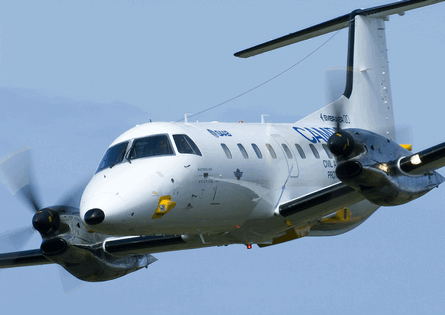Sweden's aerospace and defence industries have undergone a transformation over the past decade. One major trend has been a reverse in the split between military and civil business. Volvo Aero's experience is illustrative. Twenty years ago, 90% of the engine component manufacturer's business was military. Today, the same proportion is civil.
A related trend is the growth in importance of export markets. Here, Saab is a benchmark. At the turn of the decade, two-thirds of the manufacturer's business was domestic, with the Swedish government the major customer. Now, two-thirds of business is international.
The forces driving these trends are familiar from many western European and indeed North American markets. In September it was announced that the 2009 budget will reduce the defence forces materiel allocation by SKr2.3 billion ($343 million) the latest in a series of cuts that have forced players in the Swedish aerospace and defence industries to diversify their product lines, consolidate, collaborate on research projects, expand internationally in search of new business and look to outside investors to fund internal growth.
Some have adapted successfully. However, the government's embrace of thriftiness has drawn vocal criticism from the industry, through bodies such as Swedish Aerospace Industries (SAI), an industry association dominated by Saab, Volvo Aero and Swedish Space (SSC). SAI's major bugbear is the government's declining R&D spend.
 |
|---|
© Saab |
"They're decreasing the support, but on the other hand they would like us to be competitive with other countries - and they have much more support from their governments," says Anna Rathsman, senior vice-president information and business development at SSC and a member of SAI's board. "And the aerospace business is very specific because we have very long lead times."
SAI has undertaken a comparative study to assess levels of R&D spending in other European countries, in a bid to convince the government of aerospace's strategic importance. Rathsman acknowledges that the issue is "not so hot politically", but is confident that Sweden can follow the example of Spain, where - she says - experience proves that "if you invest a lot of money in aerospace business the whole country will lift itself".
At the European Union level, SAI's work co-ordinates that of the AeroSpace and Defence Industries Association of Europe (ASD), which has lately been active in lobbying the EU for action on the strength of the euro, citing its harmful effects on the competitiveness of manufacturers across Europe. The charge has been led by a president from outside the eurozone: Saab chief executive Åke Svensson.
Saab is also a major player in the industry association SOFF. Peter Lundberg, the association's president and chief executive, estimates that "60-70%" of its members are Saab employees. "You could say that we only have one big defence and aerospace company and that is Saab," he says. "They are in that respect the only company that is an equivalent to the big European players, and that is also why we have quite a significant role on the ASD."
Lundberg traces the history of consolidation in the Swedish defence industry. "In the 1970s and 1980s, we had a much more independent industry. We used to have 10 major suppliers covering the full spectrum of defence equipment. Some of them were state-owned, some were privately owned, but they were totally controlled by Swedish ownership. Today we are consolidated and we have foreign ownership and we have ownership abroad. We belong much more to international industry. To some extent we are ahead of many other European countries because we had the government hands taken away much earlier. The industry is on its own to manage by itself. There are pros and cons, but the good thing is that this develops eager and competitive industry as we have to fight for their survival."
HOME MARKET STILL CRUCIAL
Yet the home market remains crucial as the forum in which to generate the technology, development programmes and prototypes that serve as backbones of international co-operation. "I would say that there are no Swedish development programmes being launched without a very, very strong focus on finding international partners," says Lundberg, who estimates that export accounts for more than 50% of SOFF members' business and, in many cases, 70% or 80%.
Once a purely defence-focused body, SOFF has expanded its brief to reflect the growing importance of the homeland security market, which has been embraced by Saab and SSC, among others. "The market is pretty tough as it's a very different market compared with defence - much more fragmented. It's difficult to find the key stakeholders, but it's improving. And business is growing in that area."
Sweden's aerospace and defence industry is diverse, both geographically and by specialism. Volvo Aero, lately revealed as a risk-sharing partner on Pratt & Whitney's GTF geared turbofan project, is based in the small western city of Trollhattan, while SSC, like Saab, complements its Stockholm HQ with sites elsewhere. Its Esrange test range - in the sparsely populated north - is co-marketed with Vidsel, a neighbouring missile test range operated by FMV, the Swedish Defence Materiel Administration.
Saab's fighter-jet wing, Gripen International, operates from a base in Linköping, 200km (125 miles) south-west of Stockholm. Linköping is also home to Saab's Aerostructures business, which supplies Airbus and Boeing, and to Applied Composites, recently acquired by Volvo Aero. Almost exactly halfway between Linköping and Stockholm lies Nykoping, the home of CTT Systems. Employing just 40 people, CTT markets a condensation elimination system that has been selected for the Boeing 787.
Is there potential for further consolidation in Sweden? "I see very little left to do in Sweden," says Svensson, who recently oversaw the sale of Saab's space business to Ruag. "I don't see that there is any synergy in consolidating within Sweden... In many cases that you don't need to restructure on an ownership basis. In many cases it's better to have co-operation in certain programmes. That will be part of the future for a long time."
Source: Flight International























